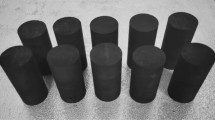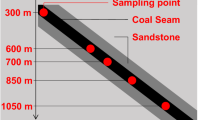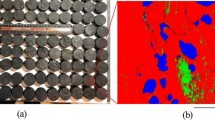Abstract
As coal mining is extended to greater depths, it is found that the mechanical behavior of deep coal differs from the mechanical behavior of shallow coal, resulting in a significant increase in accidents. To explore the characteristics of deformation damage and energy evolution of coal at different depths, coal samples from depths of 300, 600, 700, 850, and 1050 m at the Pingdingshan Coal Mine were acquired. The effects of depth on the in situ stress environment and physical properties of coal were considered, and triaxial compression experiments on 128 coal samples were conducted on this basis. The results show that as the depth rises up, the elastic modulus of coal gradually increases, reaching a maximum of 6.88 GPa in the range of 700–850 m. Poisson’s ratio, the strength, and the volume strain at failure increase nonlinearly, reaching a maximum of 0.48, 129.7 MPa and 0.81%, respectively, at the depth of 1050 m. With increasing depth, the elastic energy and dissipated energy increase more rapidly, and the corresponding peaks of 1050 m are 1.84 times and 3.1 times that of 300 m, respectively. The dissipated energy causes a more significant internal structural change in deep coal, thereby leading to more prominent macroscopic failure in the deep. From the perspective of energy conversion efficiency, it is mainly the accumulation of elastic energy at the pre-peak stage, followed by the release of elastic energy and a rapid increase in dissipated energy at the post-peak stage. The efficiency of accumulation and release of elastic energy decreases significantly in deep coal, while the generation efficiency of dissipated energy increases sharply. These results provide a useful reference for the safe and efficient exploitation of deep coal resources.












Similar content being viewed by others
Abbreviations
- E :
-
Elastic modulus, MPa
- E i :
-
Unloading modulus, MPa
- H :
-
Depth, m
- k 1 :
-
Ratio of maximum horizontal stress to vertical stress, 1
- k 2 :
-
Ratio of minimum horizontal stress to vertical stress, 1
- K :
-
Lateral pressure coefficient, 1
- U :
-
Total energy, J/m3
- U e :
-
Elastic energy, J/m3
- U d :
-
Dissipated energy, J/m3
- v p :
-
Ultrasonic longitudinal wave velocity, m/s
- σ v :
-
Vertical stress, MPa
- σ H :
-
Maximum horizontal stress, MPa
- σ h :
-
Minimum horizontal stress, MPa
- σ 1 :
-
Axial stress, MPa
- σ 3 :
-
Confining pressure, MPa
- ε 1 :
-
Axial strain, 1
- ε 3 :
-
Lateral strain, 1
- µ :
-
Poisson ratio, 1
- γ :
-
Bulk density, kN/m3
- SEM:
-
Scanning electron microscopy
References
Diering DH (1997) Ultra-deep level mining-future requirements. J S Afr Inst of Min Metall 97:249–255
He MC, Xie HP, Peng SP, Jiang YD (2005) Study on rock mechanics in deep mining engineering. Chin J Rock Mech Eng 24:2803–2813
Hoek E (1994) Strength of rock and rock masses. ISRM News J 2:4–16
Hoek E, Brown ET (1982) Empirical strength criterion for rock masses. J Geotech Eng Div 106:1013–1035
Huang JJ, Qin YG, Zhao S, Wang W, Wen L (2017) Strength response characteristics and coupling support of deep roadway in soft rock masses. Cogent Eng 4:1–15
Jiang H, Zhang L, Zhou Y (2000) Granite deformation and behavior of acoustic emission sequence under the temperature and pressure condition at different crust depths. Acta Seismol Sin 13:424–433
Kaiser PK, Kim BH (2015) Characterization of strength of intact brittle rock considering confinement-dependent failure processes. Rock Mech Rock Eng 48:107–119
Kang H, Fan M, Gao F, Hui Z (2015) Deformation and support of rock roadway at depth more than 1000 meters. Chin J Rock Mech Eng 34:2227–2241
Kidybinski A, Babcock CO (1973) Stress distribution and rock fracture zones in the roof of longwall face in a coal mine. Rock Mech 5:1–19
Kwasniewski M (1989) Laws of brittle failure and of B-D transition in sandstones. Rock at great depth. A. A. Balkema, Rotterdam, pp 45–58
Man K (2011) Depth effect on dynamic fracture toughness of rock. Metal Mine 3:19–21
Meng Q, Zhang M, Han L, Pu H, Nie T (2016) Effects of acoustic emission and energy evolution of rock specimens under the uniaxial cyclic loading and unloading compression. Rock Mech Rock Eng 49:1–14
Mikhalyuk AV, Zakharov VV (1997) Dissipation of dynamic-loading energy in quasi-elastic deformation processes in rocks. J Appl Mech Tech Phys 38:312–318
Paterson MS (1958) Experimental deformation and faulting in Wombeyan marble. Geol Soc Am Bull 69:465
Paterson MS, Wong TF (2005) Experimental rock deformation—the brittle field. Miner Mag 43:317–317
Singh JRT, Rao GV (1989) Strength of rocks at depth. Rock at great depth. A. A. Balkema, Rotterdam, pp 37–44
Steffler ED, Epstein JS, Conley EG (2013) Energy partitioning for a crack under remote shear and compression. Int J Frac 120:563–580
Sujatha V, Kishen JMC (2003) Energy release rate due to friction at bimaterial interface in dams. J Eng Mech 129:793–800
The Standardization Adminstration of China (2009) Methods for determining the physical and mechanical properties of coal and rock. Standards Press of China, Beijing, pp 1–9
Verman M, Singh B, Viladkar MN, Jethwa JL (1997) Effect of tunnel depth on modulus of deformation of rock mass. Rock Mech Rock Eng 30:121–127
Violay M, Gibert B, Mainprice D, Evans B, Dautria JM, Azais P, Pezard P (2012) An experimental study of the brittle-ductile transition of basalt at oceanic crust pressure and temperature conditions. J Geo Res Solid Earth 117:487–497
Wang MY, Li J, Ma LJ, Huang HX (2016) Study on the characteristic energy factor of the deep rock mass under weak disturbance. Rock Mech Rock Eng 49:3165–3173
Xie H (2017) Research framework and anticipated results of deep rock mechanics and mining theory. Adv Eng Sci 49:1–16
Xie HP, Yang JU, Li-Yun LI (2005) Criteria for strength and structural failure of rocks based on energy dissipation and energy release principles. Chin J Rock Mech Eng 24:3003–3010
Xie HP, Ju Y, Li LY, Peng RD (2008) Energy mechanism of deformation and failure of rock masses. Chin J Rock Mech Eng 27:1729–1740
Xie H, Gao F, Ju Y (2015) Research and development of rock mechanics in deep ground engineering. Chin J Rock Mech Eng 34:2161–2178
Xie HP, Ju Y, Gao F, Gao MZ, Zhang R (2017) Groundbreaking theoretical and technical conceptualization of fluidized mining of deep underground solid mineral resources. TunnUndergrSp Tech 67:68–70
Zhang Z, Gao f (2015) Confining pressure effect on rock energy. Chin J Rock Mech Eng 34:1–11
Zhang P, Mishra B, Heasley KA (2015) Experimental investigation on the influence of high pressure and high temperature on the mechanical properties of deep reservoir rocks. Rock Mech Rock Eng 48:2197–2211
Zhou H, Xie H, Zuo J (2005) Developments in researches on mechanical behaviors of rocks under the condition of high ground pressure in the depths. Adv Mech 35:91–99
Zhou H, Xie H, Zuo J, Shenghao DU (2010) Experimental study of the effect of depth on mechanical parameters of rock. Chin Sci Bull 55:3276–3284
Zuo J, Chai N, Zhou H (2013) Investigation on failure behavior of basalt from different depths based on three-point bending meso-experiments. Chin J Rock Mech Eng 32:689–695
Acknowledgements
This research was financially supported by the State Key Research Development Program of China (no. 2016YFC0600701), the Major Scientific Research Projects (no. 14H0782) and the China Postdoctoral Science Foundation (2017M610599).
Author information
Authors and Affiliations
Corresponding author
Additional information
Publisher’s Note
Springer Nature remains neutral with regard to jurisdictional claims in published maps and institutional affiliations.
Rights and permissions
About this article
Cite this article
Zhang, Z., Xie, H., Zhang, R. et al. Deformation Damage and Energy Evolution Characteristics of Coal at Different Depths. Rock Mech Rock Eng 52, 1491–1503 (2019). https://doi.org/10.1007/s00603-018-1555-5
Received:
Accepted:
Published:
Issue Date:
DOI: https://doi.org/10.1007/s00603-018-1555-5




